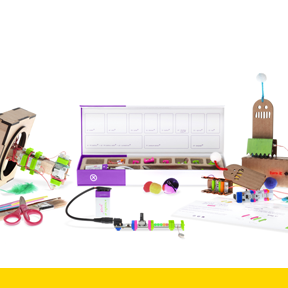1/1
littleBits
The idea behind littleBits was to create an open source library of modular electronics that snap together with magnets for prototyping, learning and fun. Just as Legos enable users to create complex structures with very little engineering knowledge, littleBits are simple, intuitive space-sensitive blocks that make prototyping with sophisticated electronics a matter of snapping small magnets together with no wiring, soldering or programming required.
Electronics are everywhere. People now produce, consume and throw out more electronic gadgets and technology-enhanced products than ever before. Yet, engineering is mysticized, electronic objects are black-boxed, and the creativity of today's designer is limited by the tools and materials available to them. With the democratization of technology and the DIY revolution gaining more momentum, creativity with electronics will explode when they can be used as (and combined with) other materials.
Rarely are people (formally) taught how to use Styrofoam or clay, yet from elementary school to design school they can intuitively build out models and test ideas for physical prototypes. Materials such as paper, cardboard and screws are intuitive, accessible, self-contained, expressive and, most of all, can be integrated early in the creative process. The challenge designers sought to solve is how to turn electronics into a material.
Each Bit has a specific function (light, sound, sensors, buttons, thresholds, pulse, motors), and modules snap to make larger circuits. Taking this one step further, and inspired by childhood construction kits, the designers imagined electronic components to be building blocks to design with. At a time where the world is interactive, they made interaction—not electronic components—the building block. It's not about the LED, it's about light; it's not about the motor, it's about motion; it's not about a resistor and capacitor, it's about responding to touch. They wanted to turn every interaction in the world into a ready-to-use brick.
On scalability, littleBits is a library. Unlike most electronic products and platforms, littleBits are not one-offs; each Bit works with every other Bit in the system, making the system more powerful. To date over 35 Bits have been released, with prototypes, designs and sketches in the works for hundreds more. The system accommodates a plethora of new Bits of varying levels of complexity so people easily create almost any interactive experience.
On accessibility, littleBits are simple and snap within seconds. The Bits are color-coded: blue is power, pink is input, green is output, and orange is wire. All you need is a blue and a green; pink and orange are optional in between. Magnets prevent you from snapping Bits the wrong way. The designers wanted to empower kids and adults alike to combine interaction with other materials, whether pipe cleaners and popsicle sticks or laser-cut acrylic and complex mechanical gears.
And finally, littleBits are open source. All the design files and technical specifications are available so that any engineer, enthusiast or amateur can download the files, learn how the Bits are made and make them themselves. littleBits aims to move electronics from the late stages of the design process to its earliest ones, and from the hands of experts, to those of artists, makers, students and designers.
发布于2019-11-29
设计奖项
美国IDEA工业设计奖
Gold/金奖
2013 年
颜色

